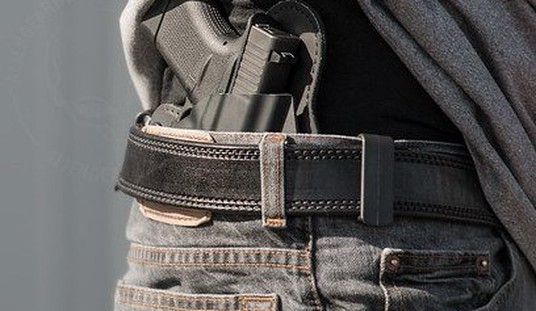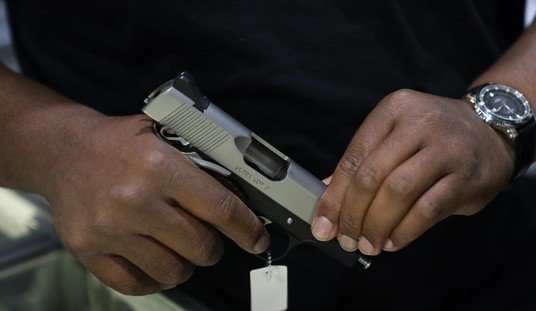Few things are more amusing that people attempting to criticize something that they clearly don’t understand.
Update: Here’s me proving that.
My Criticism Of Rob Pincus Was Dumb. Here’s Why.
A perfect example of this is Rob Pincus’s attempt to criticize not the actual Weaver Stance, but a poorly misunderstood parody of a Weaver stance.
What Pincus doesn’t seem to grasp is that the exaggerated “Wikipedia Weaver” he’s having his model emulate isn’t what Jack Weaver used. As the photo below shows, Weaver’s arms are not locked out, he’s not straight up, but is learning forward in a balanced fighting stance.


Another picture of Weaver show that he’s not cartoonishly bladed with both feet off at an odd angle as we see in Pincus’s example, but has his lead foot pointed at the target.
* * *
Amusingly, the school that is credited with making the Weaver Stance famous as part of the Modern Technique of the Pistol, Gunsite Academy, doesn’t use the Wikipedia Weaver, either.
They instead teach what Gunsite Director of Training Dave Starin calls the “fighting stance.”
When it comes to “shooting stances” I find it is much the same. You can argue pros and cons as to which is better, a Weaver stance or an Isosceles stance. Both are fine, but I prefer a fighting stance.
At Gunsite, we teach a fighting stance, with no preconceived preference as to whether or not you lock out your elbows, bend your support elbow 45 degrees or more likely, fall somewhere in between. As you will often hear us say, “We are a fighting school, not a shooting school.”
While I’ll never claim to be an expert in any aspect of firearms training, I do happen to know a little bit about the way the Fighting Stance is taught at Gunsite, as I’ve spent more than 120 hours training there in the past two years.
Here are several Gunsite instructors and a firing line of students with their takes on the Fighting Stance at taught today. I will note that many still consider this a variation of the Weaver Stance.



Now here are several photos of Gunsite students in their versions of a Fighting or modern Weaver stance.


You’ll note that the exaggerated bladed stance and perfectly upright position that Pincus has his model demonstrate doesn’t look anything at all like the Fighting Stance or modern Weaver as taught by instructors and emulated by students at Gunsite.
So what really defines the Fighting Stance, or modern Weaver?
Take it away again, Dave Starin.
- Balance is essential as it is required for everything we do, (except falling). In order to effectively defend yourself, or a loved one, you need to remain balanced in order to perform. Whether you are moving out of the way, delivering a punch, swinging a club or need to fire accurate shots, balance is a key component. Balance allows us to move quickly and efficiently.
- Your stance should provide you a stable platform from which to fight/shoot. Being stable allows us to block or deflect an attack or be solid enough to keep the sights aligned while shooting. Good stability is also required to control or manage recoil effectively, a must for quick and accurate follow up shots.
- Your ability to move quickly in any direction without preparatory movements can be critical to your survival. Balance and stability are required for good mobility. If we are off balance it is difficult or impossible to move quickly while maintaining control and coordination. Without a stable platform, moving quickly likely results in a loss of balance or traction.
It’s the “push-pull” isometric tension between hands which tames recoil… and which Pincus asserts doesn’t work.
The reality of the matter is that the “push-pull” that defines the Weaver and which is used in the Fighting Stance I’ve been taught is still taught today for a very simple reason: it works effectively in real gunfights for recoil management and gun control. It also leaves people in a much better fighting position if you have to go “hands on.” The isosceles, while good for competition target shooting, doesn’t give you good front-to-back stability, and can leave a shooter on his back in a real-world fight.
You’ll note that none of the students nor the instructors are deeply bladed at a 45 degree angle. You’ll also note that their footwork varies widely; most students have their support-side leg slightly forward, some have them nearly even, and a few of us (myself and at least one Gunsite instructor) sometimes have our gun-side leg forward. You’ll also note that both toes of the shooters also point at the target, not both off at an angle as they are in Pincus’s video.
The body of a Fighting Stance or modern Weaver shooter is not rigidly straight up and down as demonstrated by Pincus’s model, but is balanced. Depending on the practitioner, there may be varying degrees of forward lean.
The bastardized “Wikipedia Weaver” shown in Pincus’s video is not what people actually learn and practice, and his favored Isosceles is amusingly more of a range/competition stance than even the Weaver he misunderstands and derides.








Join the conversation as a VIP Member